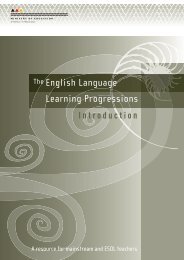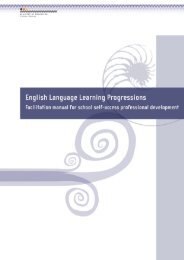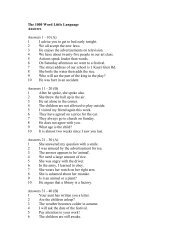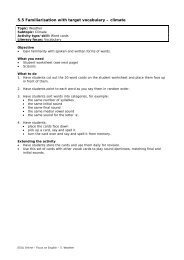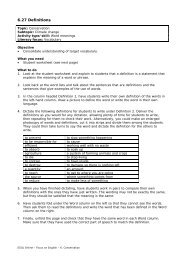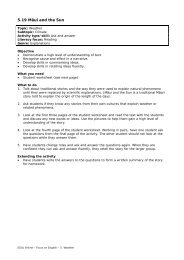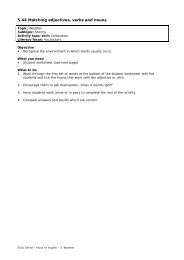ELLP Years1-4 - ESOL - Literacy Online - Te Kete Ipurangi
ELLP Years1-4 - ESOL - Literacy Online - Te Kete Ipurangi
ELLP Years1-4 - ESOL - Literacy Online - Te Kete Ipurangi
You also want an ePaper? Increase the reach of your titles
YUMPU automatically turns print PDFs into web optimized ePapers that Google loves.
Stage 1B<br />
The following sample text is at Stage 1B because it is fairly short and conceptually simple, with<br />
ideas presented in a simple sequence. The sentences are simple.<br />
<strong>Te</strong>xts at Stage 1B tend to have the following characteristics:<br />
– only a few short sentences per page;<br />
– a variety of sentence beginnings;<br />
– ideas presented in a simple sequence;<br />
– good support from illustrations;<br />
– use of high-frequency words and some topic words that are strongly supported<br />
by the context;<br />
– use of simple or compound sentences.<br />
Other examples of texts at Stage 1B include those found at the early levels on the colour wheel in<br />
the Ready to Read series books and their commercially published equivalents.<br />
Sample text<br />
Extract: Holt, Sharon (2003). Skipper’s Happy Tail. Ready to Read series.<br />
Wellington: Learning Media, pages 2–5.<br />
Topic: A dog’s tail and its effect on family members<br />
<strong>Te</strong>xt type: Narrative<br />
Audience: A young reader – the text uses simple ideas and language<br />
Topic development<br />
The text is short, and the ideas are<br />
presented in sequence. The problem is<br />
shown rather than explained. The reader<br />
needs to distinguish between a number of<br />
characters and link them to their respective<br />
actions.<br />
Skipper’s Happy Tail<br />
The children got out of the car.<br />
They helped Mum pick up the<br />
shopping bags.<br />
Skipper came to meet them.<br />
Skipper wagged his happy tail.<br />
Language structures<br />
His tail tickled Sophie’s nose.<br />
The sentences are mostly short and use<br />
“Get away, Skipper!” said Sophie.<br />
simple clauses (subject–verb–object). They<br />
“Skipper, come here!” shouted Dad.<br />
are not repetitive and have a variety of<br />
beginnings. Some direct speech is used.<br />
Dad was painting the shed.<br />
Skipper wagged his happy tail.<br />
The verb phrases are mostly in the thirdperson<br />
singular simple past – came,<br />
His tail brushed the wet paint.<br />
shouted. There are two imperative verbs<br />
used in direct speech – Get away, come.<br />
Some complex verb phrases are included<br />
– came to meet, was painting. The text also contains some phrasal verbs – got out of, pick up.<br />
26<br />
The noun phrases are mainly simple. Some noun phrases include determiners – the car, his tail.<br />
Some consist of a determiner, an adjective, and a noun – his happy tail, the wet paint. Some noun<br />
phrases also contain pronouns or possessive adjectives that are close to the noun they refer to<br />
– The children … They; Skipper … his.





